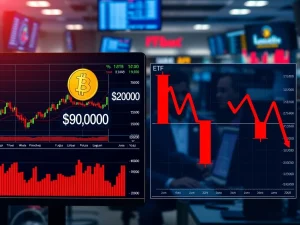Bitcoin ETPs: Dominant Holdings Surpass 7% of Total Bitcoin Supply

The cryptocurrency market recently marked a significant milestone. Bitcoin ETPs now hold an impressive 7% of Bitcoin’s maximum supply. This substantial accumulation underscores growing institutional confidence in digital assets. It also highlights the evolving landscape of crypto investment.
Bitcoin ETPs: A Dominant Share of Bitcoin Supply
Bitcoin ETPs, or exchange-traded products, collectively manage over 1.47 million BTC. This figure represents a crucial 7% of Bitcoin’s finite 21 million coin Bitcoin supply. Specifically, US-based spot Bitcoin ETFs have spearheaded this accumulation. They have gathered more than 1.29 million BTC across their eleven funds. Data shared by X account HODL15Capital on Monday, August 31, confirms these significant holdings. This demonstrates a clear trend of institutional adoption.
Among these, BlackRock’s iShares Bitcoin Trust ETF (IBIT) stands out. It commands the largest individual share. IBIT currently holds a staggering 746,810 BTC. This positions it as a dominant player in the institutional Bitcoin market. Following closely, the Fidelity Wise Origin Bitcoin Fund (FBTC) ranks second. FBTC’s holdings approach 199,500 BTC. These figures collectively highlight the rapid integration of Bitcoin into traditional financial vehicles. Global Bitcoin ETPs added over 170,000 BTC, worth approximately $18.7 billion, between December 2024 and August 2025.
Shifting Tides: Bitcoin Demand Slows as Ethereum Funds Attract Capital
Despite the substantial long-term accumulation, demand for Bitcoin ETPs has recently shown signs of slowing. Global Bitcoin ETPs recorded a net outflow of $301 million for the month of August. This marks a notable shift in market sentiment. Conversely, Ethereum funds experienced a surge in investor interest. They attracted significant inflows totaling $3.95 billion during the same period. CoinShares reported these contrasting trends on Monday. This data suggests a strategic reallocation of capital within the broader cryptocurrency ecosystem.
This slowdown in Bitcoin demand aligns with a broader market trend. Large institutional investors, often called crypto whales, are actively reallocating their portfolios. Billions of dollars are moving from Bitcoin towards Ether (ETH). For example, one prominent Bitcoin whale executed a significant trade. This individual sold 4,000 BTC for 96,859 Ether over 12 hours. This whale now reportedly holds $3.8 billion worth of Ether.
Crypto Whales Pivot to Ethereum: A Strategic Move
Blockchain data platform Arkham further corroborates this strategic pivot. Their report on Wednesday revealed that nine crypto whales collectively booked profits in Bitcoin. Subsequently, they rotated these gains into ETH. These concentrated buys amounted to $456 million. This trend indicates a calculated move by major holders. They are diversifying their digital asset exposure. Such large-scale movements by influential investors often signal evolving market expectations. This impacts both Bitcoin and altcoin markets.
The current downturn in Bitcoin’s short-term demand also aligns with historical market patterns. September has traditionally been the weakest month for the leading cryptocurrency. Meanwhile, the price of gold often notches higher during this period. Another significant factor influencing investor decisions is the regulatory landscape. As many as 92 crypto-related ETFs are pending approval with the US Securities and Exchange Commission (SEC). Some of these highly anticipated funds aim to track Solana (SOL) and XRP (XRP). Final regulatory decisions for these are due in October. This regulatory uncertainty can cause investors to adopt a cautious approach.
Navigating Future Hurdles: Expert Outlook on Bitcoin’s Path
Expert analysis offers diverse perspectives on Bitcoin’s future trajectory. Pseudonymous Bitcoin analyst PlanC provided a long-term outlook. He suggested Bitcoin’s path to $1 million might face unexpected hurdles. “Instead, we just keep grinding slowly upward to $1,000,000 over the next seven years in a very boring and underwhelming way,” PlanC commented. This view suggests a more gradual, less volatile ascent.
Research firm Delphi Digital also contributed to the discussion. They posited that Bitcoin might rally and then crash after Federal Reserve interest rate cuts. This scenario, however, depends on the asset increasing in price beforehand. Conversely, the firm stated Bitcoin’s price could remain stable. This would occur if it garnered less activity leading up to the Fed rate cut. These varied predictions underscore the complex interplay of macroeconomic factors and crypto market dynamics. Investors continue to monitor these developments closely. The significant holdings by Bitcoin ETPs nonetheless represent a foundational shift in the asset’s market structure.










